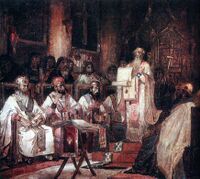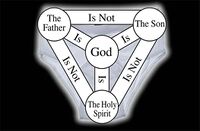First Council of Constantinople
“This time, let's make sure we're all on the same scroll.”

The First Council of Constantinople was a gathering of Christian bishops, monks and assorted holy men (some carrying the status of registered saints) gathered in the Eastern Roman capital to agree a definition about the Holy Ghost. Initially no representative of the Pope Damasus I was invited or any Latin speaking bishop. This was on the grounds that the event would be held only in Greek. In the event, Damasus sent his own envoys uninvited who discovered the council had hired translators to provide a Latin summary of the decisions.
The council was also an attempt to rectify the errors of the First Council of Nicaea where in a major oversight, no had bothered to record the minutes of what had been agreed at that event. Everyone remembered that Arius and The Arians had been declared the losers in that theological and physical battle but a definition of what the 'Nicene Creed' was exactly had been overlooked. After that, erm... what did we agree??
Background[edit]
Since the original decision to adopt the Nicene Creed there had been a number of attempts to reverse this. Usually from certain Roman Emperors (say hello to Constantius II and Valens) who wanted to stick their imperial oar in. At times it seemed likely what was orthodox one moment could be labelled heretical the next. This meeting was supposed to sort this all out once and again.
Emperor Theodosius the Great provided the accommodation in the imperial capital to discuss matters. In addition, so that his wishes (commands would be more accurate) were followed, his own candidate for Bishop Gregory of Constantinople was placed in the top position at the council. Gregory owed Theodosius a big thank you for that and promised to sanctify his patron.
As ever with Christians, the disputes revolved around how to reconcile the idea of monotheism (One God) could be accommodated in a theology that looked like worshipping two Gods (Yahweh and Jesus). In recent years the Eastern Roman Empire had been more Arian than Orthodox in its outlook with Roman Emperors like Constantius II and Valens veering in that direction which in essence was that Jesus special but no co-equal with God.
Since 380 Theodosius and his imperial colleague Emperor Gratian in the West had jointly declared that the Roman Empire was officially a Christian state. The status of other non-Christian religions like the pagans and Jews wasn't addressed. The purpose of the meeting was to make sure that everyone knew what 'Christian' now meant. All other flavours to be declared heretical including a theological position by a monk called Apollonarius that argued that Jesus was so God he was nothing else but covered in a flesh skin to mask his true identity. A bit like Terminator. This argument was to return in the following century.
Meeting[edit]
In June 381 Theodosius opened proceedings inside the Hagia Sophia by banging a gong to let the theologians start their arguments. The heated discussions about why no one had made notes from the earlier gathering were went through. This lead to accusations and counter-accusations that those who didn't agree with Bishop or Saint X was a devil worshipper or even worse, a closet pagan got plenty of Christian participants hot under the dog collar. The first presiding bishop Meletius of Antioch died half way through a meeting. His death was seen as a divine sign for something and he got rewarded with a sainthood. A martyr for argumentation.
The Updated Nicene Creed[edit]
The anathema against the Arians was agreed without a vote. Since no Arian Christians dared to poke their croziers into this debate, that wasn't a surprise. Of more substance was the re-affirmation of the Nicene Creed as understood by those present:
- God Made Everything You Can See and Not See.
- Jesus is God's only son. He has no brothers or sisters.
- God is not Jesus. Jesus is not God. Holy Ghost is neither. All are God (make a note of that please!!).
- Jesus was begotten (what ever that meant) and was not found under a burning bush or an apple tree.
- God and Jesus are one and the same.
- Jesus came to Earth via the womb of the Virgin Mary
- Mary's pregnancy was caused by the Holy Ghost whispering in her ear.
- Mary Magdelene wasn't a slapper.
- Joseph was kept out of the loop.
- Jesus lived for a bit, preached a little bit longer and then was crucified by Pontius Pilate.
- Jesus came back from the dead after three days. After a farewell tour of 40 days, he returned to heaven and sits on God's right hand side in charge of the refreshments till Judgement Day.
- Membership of the church can only come via baptism from a certified Christian.
- Sing Hallelujah by Leonard Cohen.
The issue of how the Holy Ghost worked was that it was the method how an apostle spoke and wrote about God and Jesus without making stuff or blaspheming. This Ghost or Spirit had worked previously in the whispering into the ear of St. John the Baptist and previous unshaven Old Testament prophets. It was also understood the Holy Ghost's messages came direct from God and not Jesus who preferred to carry on with his other hobbies like building shelves and making wooden toys.
This therefore elevated the Holy Ghost as the Third being in the Trinity but unlike Jesus, he had no form. He was well..spirit, like an invisible gas like Oxygen. It was also repeated that the Holy Ghost was still in operation and would guide everyone to the right decision about the nature of Christianity. No wonder non-Christians wondered why these peculiar people were making life so complicated!
Aftermath[edit]
The meeting broke up in August 381 with the news of the decisions taken being sent to the Pope in Rome. Pope Damasus I was informed of the results of the meeting. He stamped the document without reading it as he was otherwise engaged in private spiritual matters with certain Roman matrons. If had bothered to have read the small handwriting he would have noticed that the Bishop Gregory of Constantinople had listed himself as officially the Second Big Cheese in Christianity after the Pope.
Copies of the updated Nicene Creed were then distributed around the empire. However some translations were not so good. There were plenty of miscopyings and at least one scribe thought the Holy Ghost's messaging service also came via Jesus as well as God. His copy was made in Spain where it lay undisturbed for nearly 200 years
Record Taking[edit]
Despite claims this was a fully documented meeting, when the Second Council of Ephesus met in 451, they were unable to find most of what had been agreed on previously. Filing and paperwork again at fault.
References[edit]
| Preceded by: First Council of Nicaea |
Christian Councils 381 |
Succeeded by: Council of Ephesus |

